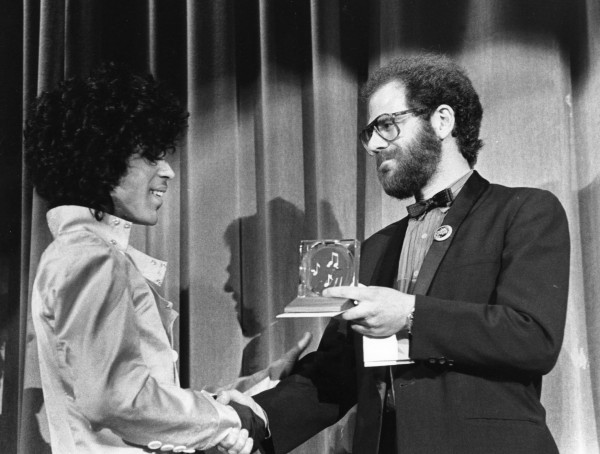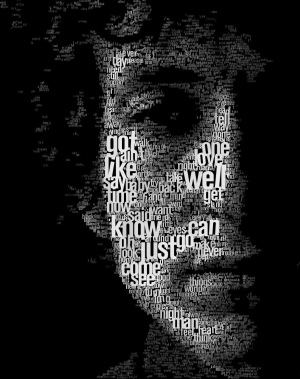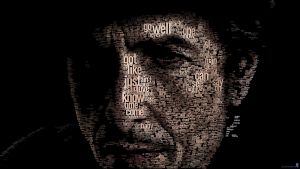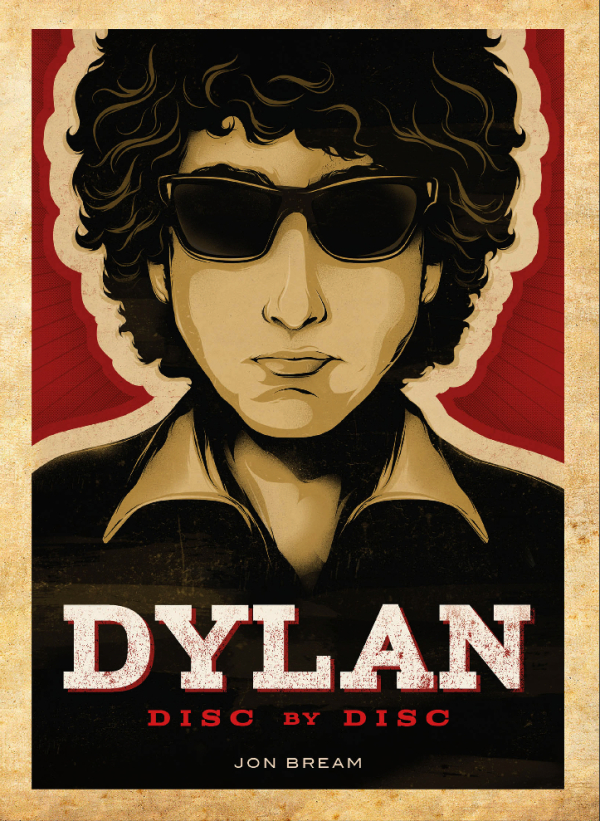When veteran music journalist Jon Bream was asked by Voyageur Press to write book-length series of essays about every Dylan album, he came back with a counter-proposal: how about if I pair high profile music critics (Robert Christgau, Anthony DeCurtis, Alan Light) with high profile musicians (Questlove, Ric Ocasek, Jason Isbell) and have them sit down and have a conversation about a particular Dylan album, voila, the book writes itself? Voyageur was soon sold on the idea and earlier this year they published Dylan: Disc By Disc, curated, compiled and edited by Bream [pictured below with Prince circa 1983/photo by Mark Peterson], who’s been a music critic for the Minneapolis Star Tribune since 1975. Recently, we got Bream on the horn to talk turkey about the making of the book, the meaning of the man’s work, as well as his personal encounters with Dylan over the years as both a journalist and a fan.
PHAWKER: I really enjoyed the book, it was my go-to bathroom read for all of June, I’ll have you know.
JON BREAM: Well thank you, that’s one of the intentions of the book. Seriously, I said to people it’s like bathroom reading. Because you can read one chapter at a time, they’re relatively short. You don’t need to read it in order, you just have to pick it up and read a chapter.
PHAWKER: Let’s start with your back story with Dylan. When, how, why did you get into Bob Dylan? What was your ‘Ah-ha!’ moment?
JON BREAM: Oh there were many ‘Ah-ha!’ moments, I mean obviously, I listened to him as a kid growing up,  I’ll bet my real “Ah-Ha!” moment I suppose was the first time I saw him in concert in 1974 with The Band in Bloomington, Indiana. He didn’t come to Minnesota, but I went down there, and I drove back that same night in a snowstorm, and it was a pretty amazing performance. You know you’d heard about the reputation and all of that, but to actually see him live after that long layoff, was pretty powerful. And then you know, he’s a local guy, and I went up to him at 1974, later that year, at a Ry Cooder concert in a ballroom in downtown Minneapolis. I just walked up to him and introduced myself and told him I had some photos of him which I had found, I worked at the University of Minnesota Daily. I said ‘I had found some photos of you in a desk and it was some photos of you performing at the old Ten O’Clock Scholar coffeehouse with Spider John Keorner and there were photos of Bob Zimmerman, at a typewriter in the Minnesota Daily offices. We used that photo many times to try to recruit people to write for our newspaper.’
I’ll bet my real “Ah-Ha!” moment I suppose was the first time I saw him in concert in 1974 with The Band in Bloomington, Indiana. He didn’t come to Minnesota, but I went down there, and I drove back that same night in a snowstorm, and it was a pretty amazing performance. You know you’d heard about the reputation and all of that, but to actually see him live after that long layoff, was pretty powerful. And then you know, he’s a local guy, and I went up to him at 1974, later that year, at a Ry Cooder concert in a ballroom in downtown Minneapolis. I just walked up to him and introduced myself and told him I had some photos of him which I had found, I worked at the University of Minnesota Daily. I said ‘I had found some photos of you in a desk and it was some photos of you performing at the old Ten O’Clock Scholar coffeehouse with Spider John Keorner and there were photos of Bob Zimmerman, at a typewriter in the Minnesota Daily offices. We used that photo many times to try to recruit people to write for our newspaper.’
PHAWKER: And you were a college student in 1974?
JON BREAM: In ‘74 I was a college senior. And I didn’t know that you weren’t supposed to go up and talk to Bob Dylan. Because ever since then I was waiting for him to come up to me or for someone to introduce me to him or reintroduce me. I mean he remembers me, but I didn’t know I was naive so I just walked right up and talked to him. He was sitting in a booth, with a friend of his and for some strange reason he wasn’t guarded enough to be on the inside of the booth he was sitting on the outside, so I went up to him and said: ‘We have these photos, would you like me to send the photos?’ And he said ‘Yeah send them!’ like he assumes everyone knows Bob Dylan’s address.
PHAWKER: Right. Did he give you an address?
JON BREAM: No, I didn’t ask him for one. He just said ‘send them,’ and I walked away thinking: Well where do I send them?
PHAWKER: So did you send them?
JON BREAM: No I couldn’t figure out where to send them to. Columbia Records? But I don’t think it wouldn’t have gotten very far.
PHAWKER: You could have just put BOB DYLAN’S HOUSE on the envelope and the postal service would have got it to him eventually.
JON BREAM: Exactly. BOB DYLAN’S HOUSE, WOODSTOCK.
PHAWKER: But you’ve met with him on more than one occasion and had conversations or interviews with him over the years, correct?
JON BREAM: I’ve did a formal interview with him around the time of Renaldo and Clara, and I hung out with him for two days in 1986 in California and then I’ve talked to him informally several times.
PHAWKER: And why were you hanging out with him for two days in ‘86?
JON BREAM: Well he was scheduled to perform in Minneapolis at the Metrodome which used to be our football and baseball stadium that just got torn down, but it opened in ‘82 and in ‘86 he was going to be the first concert there with the Grateful Dead and he hadn’t performed in the Twin Cities since ‘78, so we decided:“Let’s get an interview with Bob Dylan”. So I went out to Berkeley California where he was playing two nights at an amphitheater, and got a backstage pass, eventually found my way to Dylan and hung out with him for two days. Because he knew me, I mean his manager had tried to keep me at arm’s length but when I got to Bob he was like: ‘Jon? Come on in.’
PHAWKER: Wow.
JON BREAM: So we hung out for two days. He said, ‘put the tape recorder away’ and so we just hung out and talked and you know I was there in his dressing room when he was changing clothes and he didn’t tell me to leave [laughs] and you know we walked all the way up to the stage talking together and you know where that line of demarcation is where if you step across it people will see you on stage so I stopped, and I had an all-access pass so I went over and stood by the soundboard and I’m sitting there taking notes and all of a sudden I look to my right and there’s Jerry Garcia standing there next to me. I mean I got to hang out with Bob next to the soundboard and Jerry Garcia is running commentary on the Dylan concert.
PHAWKER: And this is all on the record? He just didn’t want you to use a tape recorder?
JON BREAM: He didn’t want to do an interview he just wanted to hang out and chat. We would talk about music and things like that and what was going on in Minnesota. He could be surprisingly normal.
PHAWKER: Now, The Grateful Dead tour is almost universally considered to be the nadir of Bob Dylan’s descent into premature decrepitude — or as I call it, The Fingerless Glove Years — before his before his return to vitality from the late ’90s. What kind of shape was he in at that point?
JON BREAM: I mean he was in good physical shape. You know, I think he was struggling with his writing. He played for me the album Knocked Out Loaded before it came out. He gave me a cassette to listen to, so I’m listening to the cassette with headphones in front of him and having to give him a review of one of the worst Dylan albums ever, so I found something positive to say. You know, I think I praised the song he wrote with Sam Shepard and then I think I praised the Kris Kristofferson song that was on there. It’s one of those things that happens sometimes when you listen to an album and you’re faced with an artist or a manager or a superfan will come up to you and say ‘What do you think?’ Well you always find something positive to say like ‘Geez. the lights were great’, you know?
PHAWKER: Tell me something crucial you learned about Dylan in the process of making or putting this book together that you did not know prior?
JON BREAM: Well, I certainly reassessed my opinion of a lot of the albums. Because most of them I hadn’t listened to for years and in terms of factual or nuggets the one ‘ah-ha’ moment that kind of stands out for me was when we were talking about Blonde on Blonde there was a conversation with Jason Isbell, the great Americana artist and Geoff Hines who writes for The Washington Post among various other things, and I asked a question that I think was: ‘What did you think of the album cover?,’ which was this fuzzy photo and what do you think of the album title Blonde on Blonde? Jason Isbell said: ‘Well, I just assumed it was a case of taking a Telecaster made out of blonde wood and plug it into a Vibrolux amplifier which was blonde and that gives you ‘blonde on blonde’ in musician’s terms. And all of a sudden there was just this moment of long silence on the line with both Geoff Hines and me like ‘Wow, I never thought of that, I never knew that.’ And it seems like so basic and simple and common sense, you’re trying to read something more highfalutin’ and significant into the title and maybe it was just the blonde guitar into the blonde amplifier.
PHAWKER: You you said you hadn’t listened to the records in a very long time, what were some of the albums that, having revisited them, they moved up much higher along the hierarchy in your mind?
JON BREAM: Well first of all, Self-Portrait doesn’t sound as bad in retrospect as it did at the  time it came out. Especially after hearing Self-Portrait 2 when you look at the arc of Dylan’s work, you get an idea that this was his first, well, second nod to his roots and influences you know one being the early albums where he covered folk and blues songs that other people had written, and Self-Portrait was just covers of pop songs of artists he liked and things that influenced him. But in retrospect, it sounds a whole lot better. At the time, it was pretty universally trashed. I mean there was the great voice of our generation doing cover songs at the critical time in his career where you wanted him to be great again. The other one that changed for me, Jonathan, was the three so-called ‘Christian’ albums. Which at the time we were kind of like ‘Ooh…what is he doing? Why is he doing this?’ But if you listen back to them and analyze them musically, they’re pretty strong. You know, and the singing is great and the arrangements are interesting and different in the way he used the gospel choir and stuff. And then it fits in the arc of what he’s been doing, I think, his entire career: an examination of various styles of American music. Sometimes, you can listen to what he does and see the source material for it, sometimes it’s just straight ahead cover songs, sometimes its tribute, and sometimes he just melded the things together and created his own sound and vision.
time it came out. Especially after hearing Self-Portrait 2 when you look at the arc of Dylan’s work, you get an idea that this was his first, well, second nod to his roots and influences you know one being the early albums where he covered folk and blues songs that other people had written, and Self-Portrait was just covers of pop songs of artists he liked and things that influenced him. But in retrospect, it sounds a whole lot better. At the time, it was pretty universally trashed. I mean there was the great voice of our generation doing cover songs at the critical time in his career where you wanted him to be great again. The other one that changed for me, Jonathan, was the three so-called ‘Christian’ albums. Which at the time we were kind of like ‘Ooh…what is he doing? Why is he doing this?’ But if you listen back to them and analyze them musically, they’re pretty strong. You know, and the singing is great and the arrangements are interesting and different in the way he used the gospel choir and stuff. And then it fits in the arc of what he’s been doing, I think, his entire career: an examination of various styles of American music. Sometimes, you can listen to what he does and see the source material for it, sometimes it’s just straight ahead cover songs, sometimes its tribute, and sometimes he just melded the things together and created his own sound and vision.
PHAWKER: How did you arrive at the format for the book? Which, for the benefit of the reader who may not know, is you paired up a high profile musician with a high profile critic or music journalist, assigned them a Dylan album and then recorded them having a conversation about it. The book is comprised of the transcripts of those conversations.
JON BREAM: The publishers, Voyager Books, approached me to do what they called an ‘illustrated discography ‘so they wanted me to write an essay about each of Dylan’s records and studio albums, and they would run a bunch of photos related to each of the eras with him, and I said: ‘Well, I’m flattered that you asked me, but my name probably doesn’t, in the Dylan world, mean much outside the world of Minnesota.’ I said: ‘Wouldn’t it be more interesting, since people always debate Dylan, you know some people love him some people hate him, every album seems to get a different reaction, and a divided reaction, what if I invited different commentators to comment on each album and I would moderate a discussion between two different people on each album?’ And the publisher liked that topic and so I would get critics, I would get professors who teach Dylan classes, and then I would reach out to some musicians who are Dylan fans. And so that’s what I did. And I would say about 20% of the contributors, mostly the critics and a few artists, were people I know, but most everyone was a cold call. And then I asked people, ‘Do you know any artists who are into Dylan? Blah Blah Blah’ and I tried to reach directly to artists as opposed to going through their managers or press agents or publicists, whatever. I think when I went through a manager or publicist I was 3 for 34 at getting people to participate. And sure, lots of big name artists, real big name artists turned me down, several real big critics turned me down or didn’t respond, but I think we ended up with a real interesting group of commentators.
PHAWKER: How did you go about pairing albums with commentators?
JON BREAM: The matchmaking was the tricky part. Plus. the whole logistics of the project were probably the most challenging thing. What I did was I asked everyone to submit 10 albums that they would like to do. In other words I said I don’t care if you like it or dislike it but if you feel strongly about it, rank it in order, and then rank five albums you absolutely don’t want to talk about. Now in the case of Robert Christgau, he said there was only one album he was interested in talking about. So if I wanted Bob Christgau in the book, he got his one and only choice, which he did. But then I just had to kinda pair people together. And sometimes it turned out to be serendipitous magic, the two commentators I ended up with Slow Train Coming, I had no idea that the one guy was a born-again Christian and the other guy was a proud Jew. But it was the perfect combination of commentators. You know, when I paired two of your home boys there, Ahmir “Questlove” Thompson and Wesley Stace, also known as John Wesley Harding, I had no idea that they recorded in the same studio in Philadelphia but didn’t know each other. I had no idea that say, the album that Ahmir had picked out as his number one choice, Saved, had such a profound effect on him as a 9-year-old, and that the same album had such a profound effect on Wes Stace as a 15-year-old. But sometimes you get lucky.
PHAWKER: And the only record that Christgau would talk about was New Morning? Why that record?
JON BREAM: That was the only one that interested him. He said he’s not a Dylan fan, he doesn’t read any Dylan biographies, but he did do research, he went into the library and I know he read Christopher Ricks’ comments on New Morning. And he definitely did research because he was well-informed about the album. I would say almost all of the commentators put in some degree of research, because they were pretty fluent in their comments on the records and they were very knowledgeable.
PHAWKER: Now, have you sent Dylan a copy or heard anything back?![]()
JON BREAM: I don’t have the address. (Laughs).
PHAWKER: Still? After all these years?
JON BREAM: I have not sent Dylan a copy, I don’t know that I need to send Dylan a copy, I’m sure he can find it. I don’t know if he’s aware of it or not.
PHAWKER: This is the part of the interview where you ask me what is my favorite Dylan album…
JON BREAM: What is your favorite Dylan album, Jonathan?
PHAWKER: Glad you asked me that. I’m a pretty stern taskmaster when it comes to Dylan — with great power comes unsparing accountability, as it were. For me the Holy Trinity is Bringing It All Back Home, Highway 61 and Blonde on Blonde, but in my considered opinion, it’s over after that. I think there occasional moments of brilliance in the ‘70s and ‘80s, but all those albums are at best wildly inconsistent and others just plain suck. I like the Never Ending Tour Era, but to me it just seems like a different artist than that guy from the ’60s. For me it’s like Greenwich Village ‘61 to Big Pink ‘67 and then roll credits. You have an amazing career and an amazing body of work and an incredible narrative of arc. And I know this is blasphemous to say, but I am one of the few Dylan fans who’s not a fan of Blood on the Tracks. Everyone tells me I’m crazy but to me it sounds like caricature of Dylan that the haters think of whenever you bring up Bob Dylan. I think he still wrote strong lyrics over the years on more than one occasion, but after Blonde On Blonde, he just seems like a lost and wandering fellow for so many years.
JON BREAM: But that’s what makes this book a lively and compelling work I think is because people disagree and they debate Dylan. What some people like other people dislike, and so that’s why I tried to get lively commentators. I mean there’s only a couple contentious discussions, there’s some where people disagree a little bit here and there but there are a couple that are downright contentious, at times anyway. And I had no idea how it was going to come out.
JON BREAM’S DYLAN: DISC BY DISC IS AVAILABLE WHEREVER FINE BOOKS ARE SOLD

